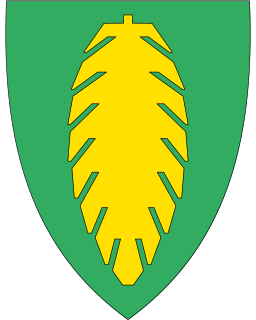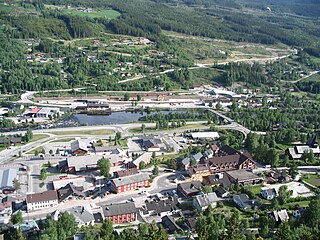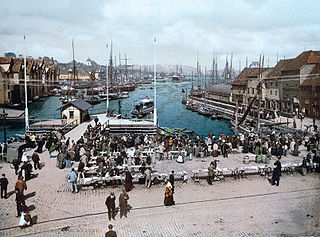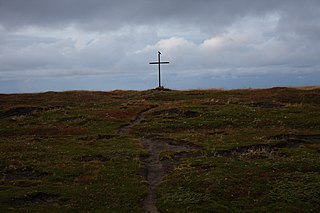It is proposed that this article be deleted because of the following concern:
If you can address this concern by improving, copyediting, sourcing, renaming, or merging the page, please edit this page and do so. You may remove this message if you improve the article or otherwise object to deletion for any reason. Although not required, you are encouraged to explain why you object to the deletion, either in your edit summary or on the talk page. If this template is removed, do not replace it . The article may be deleted if this message remains in place for seven days, i.e., after 16:56, 13 December 2021 (UTC). Find sources: "Greeks in Norway" – news · newspapers · books · scholar · JSTOR Nominator: Please consider notifying the author/project: {{ subst:proposed deletion notify |Greeks in Norway|concern=Per [[Wikipedia:Articles for deletion/Serbian Brazilian|this]], [[Wikipedia:Articles for deletion/Latvian Brazilians|this]], [[Wikipedia:Articles for deletion/Finnish Brazilians|this]], [[Wikipedia:Articles for deletion/Macedonians in Brazil|this]], [[Wikipedia:Articles for deletion/Romanian Brazilians|this]], [[Wikipedia:Articles for deletion/Jamaican Brazilian (2nd nomination)|this]], [[Wikipedia:Articles for deletion/Maltese in Belgium|this]] and [[Wikipedia:Articles for deletion/Ugandan Australians|this AFD]], these is no need for this page. The page fails [[WP:NOTEVERYTHING]] in that it's not encyclopedic with stubs about every possible diaspora group in the world.}} ~~~~ |
| Total population | |
|---|---|
| 3,246 (2019 Official Norway estimate) [1] 0.06% of the Norwegian population | |
| Regions with significant populations | |
| Oslo | |
| Languages | |
| Norwegian, Greek | |
| Religion | |
| Greek Orthodox Church | |
| Related ethnic groups | |
| Greek diaspora |
Greeks in Norway form one of the country's smaller immigrant groups.
The Greek community in Norway consisted of 1,671 [2] individuals in 2009, up from 1,572 [3] in 2008. As of 2009, 673 were immigrants, 41 were born in Norway to two immigrant parents, and 809 were born in Norway to an immigrant parent. The majority are established in Oslo. In 2019 the number of Greeks in Norway was 3,246.
A number of the 7,600 Eastern Orthodox in Norway are Greeks. The primarily Greek congregation of the Annunciation of the Theotokos was founded in 1965 in Oslo with the main purpose of serving the Greek Orthodox community in Norway. The church is administrated under Metropolitan Pavlos Menevissoglou, based in Stockholm. The congregation celebrates the Divine Liturgy approximately once a month through the services of Archimandrite Evmenios Likakis or other Greek clergy who travel to Oslo for the occasion. In addition, St. Michael's Orthodox Church is a small Greek community in Bergen with 98 members, . [4]

This article is about the demographic features of the population of Norway, including population density, ethnicity, education level, health of the populace, economic status, religious affiliations and other aspects of the population.

Hurdal is a municipality in Akershus in Viken county, Norway. It is part of the traditional region of Romerike. The administrative centre of the municipality is the village of Hurdal.

Gol (help·info) is a municipality in Buskerud in Viken county, Norway. It is part of the traditional region of Hallingdal. The administrative center of the municipality is the village of Gol which is also the population center. Gol was established as a municipality on 1 January 1838. The area of Hemsedal was separated from Gol in 1897 to become a separate municipality. The municipality of Gol is bordered to the north by the municipality of Nord-Aurdal, to the east by Sør-Aurdal, to the south by Nes, and to the west by Ål and Hemsedal.

Ål is a municipality in the traditional and electoral district Buskerud in Viken county, Norway. It is part of the traditional region of Hallingdal. The administrative centre of the municipality is the village of Ål. The parish of Aal was established as a municipality on 1 January 1838. The area of Hol was separated from the municipality of Aal in 1877 to become a separate municipality.

Lardal is a former municipality in Vestfold county, Norway. The administrative centre of the municipality was the village of Svarstad. The parish of Laurdal was established as a municipality on 1 January 1838. The municipality was divided into the parishes of Svarstad, Styrvoll, and Hem.

Islam is the second largest religion in Norway after Christianity. As of 2020, the number of Muslims living in Norway was 182,826. The majority of Muslims in Norway are Sunni, with a significant Shia minority. Fifty-five percent of Muslims in the country live in the counties of Oslo and Akershus. The vast majority have an immigrant background, with Norwegians of Pakistani descent being the most visible and well-known group.
Pakistani Norwegians are Norwegians of Pakistani descent, around half of the Pakistani population in Norway are Punjabis and 65.23% of Pakistanis in Norway live in the capital Oslo. First generation Pakistani Norwegians, who migrate from Pakistan, are distinguished from the mainstream in several demographic aspects, while second-generation Pakistani Norwegians, who are born in Norway, are well established in Norway and have gone on to become professionals and politicians.

Eastern Orthodox Christianity in Norway is a small minority religion in Norway with 11,205 official members in 2012, up from 2,315 in 2000.

Greece–Norway relations are foreign relations between Greece and Norway. The Greek Embassy in Oslo opened in 1980 and the Norwegian Embassy in Athens opened in 1974.

Turks in Norway or Norwegian Turks refers to ethnic Turks living in Norway. The majority of Norwegian Turks descend from the Republic of Turkey; however there has also been Turkish migration from other post-Ottoman countries including ethnic Turkish communities which have come to Norway from the Balkans, the island of Cyprus, and more recently Iraq and Syria.

Christianity is the most adhered to religion in Canada, with 67.3% of Canadians identifying themselves as of the 2011 census. The preamble to the Canadian Charter of Rights and Freedoms refers to God. The monarch carries the title of "Defender of the Faith". The French colonization beginning in the 17th century established a Roman Catholic francophone population in New France, especially Acadia and Lower Canada. British colonization brought waves of Anglicans and other Protestants to Upper Canada, now Ontario. The Russian Empire spread Orthodox Christianity in a small extent to the tribes in the far north and western coasts, particularly hyperborean nomadics like the Inuit. Orthodoxy would arrive in mainland Canada with immigrants from the eastern and southern Austro-Hungarian Empire and western Russian Empire starting in the 1890s; then refugees from the Soviet Union, Eastern Bloc, Greece and elsewhere during the last half of the 20th century.
In 2017, Norway's immigrant population consisted of 883,751 people, making up 16.8% of the country's total population. Of this number, 724,987 are foreign-born, while 158,764 are Norwegian-born with foreign-born parents. The ten most common countries of origin of immigrants residing in Norway are Poland (97,197), Lithuania (37,638), Sweden (36,315), Somalia (28,696), Germany (24,601), Iraq (22,493), Syria (20,823), Philippines (20,537), Pakistan (19,973) and Eritrea (19,957). The immigrant population comprises people from a total of 221 countries and autonomous regions, but 25% of the immigrants are from one of four migrant groups: Polish, Lithuanians, Swedes and Somalis.

The Western Norway region of Norway showed the highest population growth rate in Norway in 2010, at 1.44%. The fertility rate in this region is higher than in other parts of Norway. The population as of 1 January 2010 was 1,263,464, with 37.7% of the population living in Hordaland, 33.8% in Rogaland, 19.8% in Møre og Romsdal, and 8.4% in Sogn og Fjordane. 60% of the population is under 40 years old, and 30% is under 20 years old. Many of the historical immigrants in Western Norway came from countries like Scotland, England, Netherlands, Germany, Denmark and Sweden. Western Norway is the part of Norway which has the largest immigration from the western world.

Christianity is the largest religion in Norway. Norway has historically been called a Christian country. A majority of the population are members of the Church of Norway with 68.7% of the population officially belonging to the Evangelical Lutheran Church of Norway in 2019. At numerous times in history, Norway sent more missionaries per capita than any other country. This changed considerably from the 1960s. In 2004, only 12% of the population attended church services each month. Citizens born in Norway to one or two Norwegian parents are automatically added to the list of Protestant Christians in Norway, and are required to "sign out" of the church. There are two categories kept in the church's books, medlemmer ('members') and tilhørige. Members technically have to be baptised, whereas tilhørige are to be taken out of the books if not baptised by the age of 18. Norwegian citizens' tax funds are given to the Protestant Church until one registers as a member of another religious group, or as a member of the Humanist association.
African immigration to Norway refers to immigrants to Norway from Africa. An estimated 131,700 people in Norway are either first or second generation immigrants from Africa. Most of these have a background as asylum seekers.

Afghanistan has an embassy in Oslo. Norway has an embassy in Kabul.
There is a fast-growing Oriental Church in Bergen, Norway, named Saint Michael's Orthodox Church, with 147 members in 2010. It is almost exclusively made up of Ethiopians and Eritreans. The number of Eritreans in Norway grew from 813 in 2000 to 7,728 in 2010, while the number of Ethiopians grew from 2,803 to 5,805.
The Albanians in the Nordic countries refers to the Albanian migrants in Nordic countries such as Denmark, Faroe Islands, Finland, Norway and Sweden and their descendants.
Somalis in Norway are citizens and residents of Norway who are of Somali descent. They are the biggest African migration group in Norway. 36.5% of Somalis in Norway live in the capital Oslo. Almost all Somali in Norway have come to Norway as refugees from the Somali Civil War. In 2016, Somalis were the largest non-European migrant group in Norway.

Russians in Norway are people born in Russia or whose parents were both born in Russia and who live in Norway.